Samsung Galaxy S 4 ZeroLemon 7500 mAh Extended Battery Review
by Brian Klug on July 23, 2013 3:15 PM EST- Posted in
- Smartphones
- Samsung
- Mobile
- Battery
- Android 4.2
- Galaxy S 4
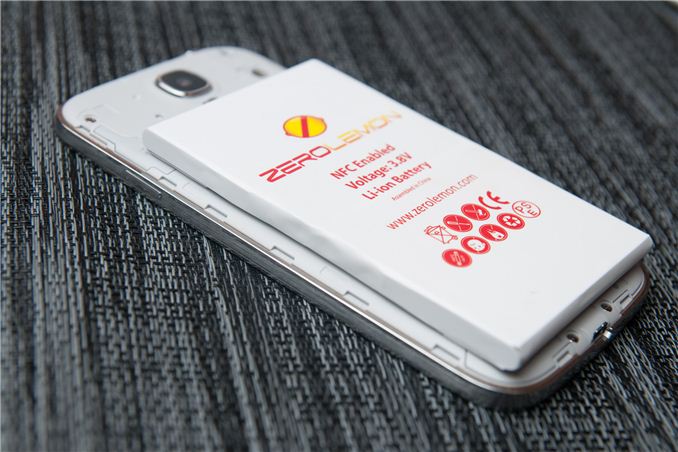
One of the chief differentiators with the Samsung Galaxy S 4 versus other current flagship Android devices is the continued support for user-replaceable batteries. Although removable batteries are becoming increasingly scarce as industrial designers prioritize aesthetics and thinner profiles, being able to swap batteries or substitute in a larger one is still an added convenience if you absolutely need it.
I’ve been carrying the Samsung Galaxy S4 Google Play edition (henceforth SGS4 GPe) alongside the HTC One GPe since getting the two devices, and while I have a Mophie Juice Pack for the HTC One, I didn’t really have a bigger battery solution for the SGS4 GPe. Probably my biggest use case for extended batteries is when I’m traveling, where having a bigger battery often is the difference between being able to relax and searching for an outlet in a terminal. When I saw the ZeroLemon 7500 mAh battery mentioned on Reddit’s r/android and instantly knew I wanted to give it a try and put it through our battery life and charge test routine.
First, the ZeroLemon 7500 mAh battery is considerably bigger than the stock SGS4 battery, which came in at 2600 mAh. Both are 3.8V nominal chemistries, so that works out to 28.5 Whr for the ZeroLemon, and 9.88 for the stock one, a scaling of 2.88 in battery capacity. Because energy density doesn’t change between the two (fundamentally it’s still the same 3.8V Lithium-Ion polymer), the extended battery achieves its larger capacity by increasing volume. As always, this is the tradeoff that industrial designers have to make – increasing battery capacity at present necessitates more volume dedicated to it.
The extended battery is really two pieces. The first is shaped like the stock battery and fits inside the housing, the second seems to be two larger cells above it which protrude from the back of the SGS4. As a result, the extended battery requires a different kind of battery cover entirely.
The ZeroLemon’s battery cover isn’t so much a door as it is a rubberized case that fits on and wraps around the SGS4. It covers the volume rocker and power buttons, and imparts a somewhat squishy feel to them. There are also holes for the microphone, headphone jack, IR Tx/Rx port, and at the bottom microUSB and speakers. The rear facing speaker on the SGS4 gets covered up somewhat, although sound still leaks between the battery and chassis and out the grille at the bottom. The far bottom of the battery does somewhat occlude the lower primary Tx/Rx antenna on the SGS4, although I haven’t seen a dramatic change in RF performance.
Obviously the weight and size of the SGS4 changes with the case and extended battery installed, the question is how much. The tradeoff with the bigger battery is that the SGS4 gets considerably bigger, but not unwieldy so. It’s a big phone for sure though.
| Samsung Galaxy S 4 Extended Battery | |||||
| Battery | Stock 2600 | ZeroLemon 7500 mAh | |||
| SGS4 Thickness With Door | 7.94 mm | 17.0 mm | |||
| Battery Mass | 43.5 grams | 132.3 grams | |||
I ran our normal smartphone battery life test suite on the SGS4 GPe with the big battery installed. This is the same test we’ve run for a while now with the display set to 200 nits exactly and loading through a number of pages on a schedule, over both WiFi and cellular (in this case for consistency with the previous GPe test, still T-Mobile LTE). Obviously the results speak for themselves here, runtime with the big 2.8x size battery is huge.
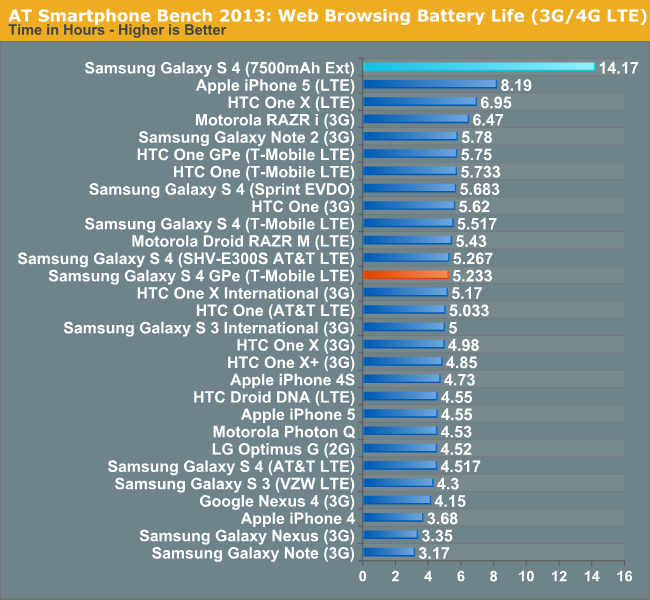

On the cellular test, we see a 2.7x scaling, very close to the expected 2.8x scaling given the increase in battery. On the WiFi test, we see just over 3x scaling, even better. I previously had no issues getting through a day with the stock SGS4 battery, I’d expect with the nearly 3x scaling you could possibly get 3 days of use out of this combo.
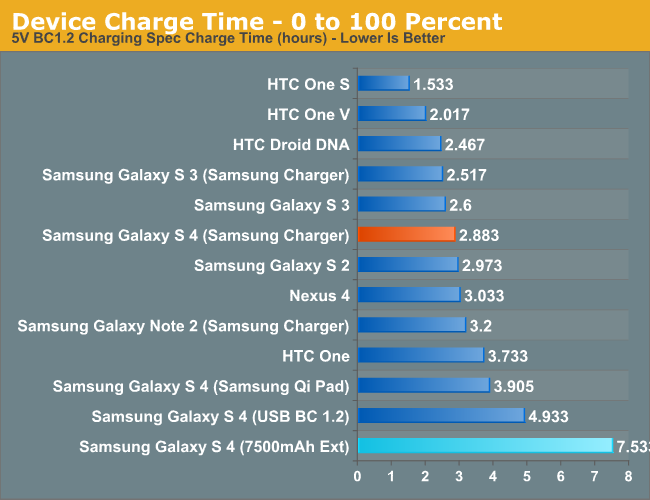
The other tradeoff is of course an increase in charge time. Samsung is in a better position here thanks to the availability of 2 Amp (10 watt) charging using their supplied charger which includes proprietary 1.2V signaling on D+/D- pins. Unsurprisingly charge time goes up as well with the ZeroLemon, and even with that Samsung 2 Amp charger, it takes 7.5 hours to charge the ZeroLemon battery from completely empty. With this much charge time, it’s clear to me that without increased charging current this is effectively the maximum practical battery size for the SGS4, given the expectation that you can plug your phone in dead when you go to sleep and wake up with it fully charged (and sleep 8 hours a night). If you use the wrong charger (USB BC 1.2 compliant), a full charge could take just over 12 hours given this same scaling.
If you’re willing to make the size and weight tradeoff and want an absolutely huge extended battery for the SGS4, the ZeroLemon 7500 mAh battery seems like a pretty good choice.
Source: ZeroLemon (Amazon)


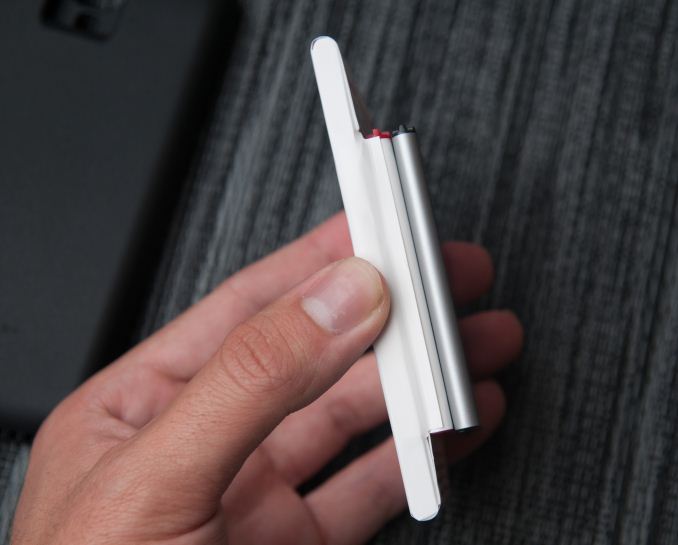
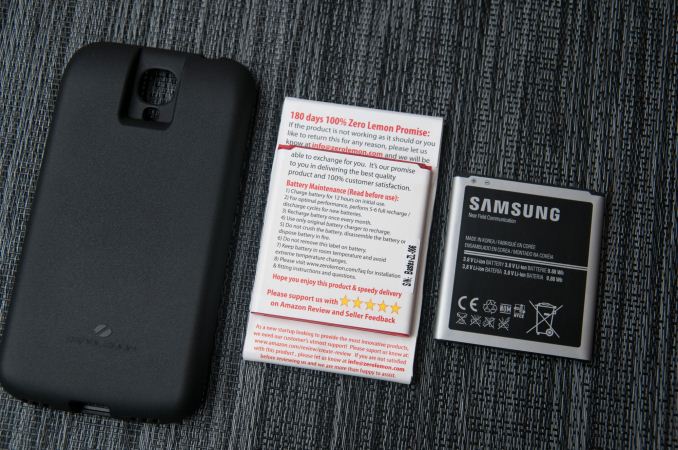















75 Comments
View All Comments
frypan - Wednesday, July 24, 2013 - link
i use to think like that until you truly use your phone to its limit. Form factor doesn't matter afterwards because a powerless phone is just a powerless brick.Extra battery is nice and all but when you swap battery out as much as I do, you start to break the back cover of the galaxy s4. not much point of having the phone slim if i have a crack cover
Connoisseur - Tuesday, July 23, 2013 - link
I'll wait for Samsung to hopefully release their official extended battery. I bought the oem extended battery for the S3 and it struck a perfect balance between thickness and extended use (2100mah to 3000). With the battery I could easily go a full 20-24 hours with moderate to heavy use and the increased thickness actually made the phone more pleasant to hold. I'd rather not my phone turn into a huge brick.flyingpants1 - Tuesday, July 23, 2013 - link
So you paid more, and you got a 42% increase instead of a 280% increase. I see.flyingpants1 - Tuesday, July 23, 2013 - link
Sorry, 200%.Connoisseur - Wednesday, July 24, 2013 - link
Yup. I also got a phone I can still easily pocket and that's still slim. For my usage, I don't need a phone that lasts 2-3 days. Just something that guaranteed lasts about 16-20 hours regardless of usage. I don't feel like carrying around a brick.TrackSmart - Tuesday, July 23, 2013 - link
Can you comment on the truthfulness of this Amazon Review? I don't know if you've had it long enough to notice how the plastic wears. And I don't know that the battery contact issue is a problem as long as you don't drop your phone in water."First of all, there is no actual "Back" of the phone with this battery on, the case that is provided IS the back. This means ZERO water protection, as the bare contacts of the battery are quite exposed through the speaker grill cutouts on the bottom of the case."
"Most noticeably, however, is the horrible wearing of the TPU. I have had the case since Sunday, yet it is already a nasty yellowing color, that I imagine will get much worse with time."
Thanks for doing the tests. I'll stick with the stock battery on my phone, given my usage needs, but its good to know that products like this exist and actually give the promised runtime.
frypan - Wednesday, July 24, 2013 - link
Get the black case. I think you can contact zerolemon and they will help you out on it. I got a case from them free of charge no questions asked.apak32 - Tuesday, July 23, 2013 - link
Any batteries that only have 2x more capacity? I'd like less bulk. Good quality ones of course. I've bought non-OEM extended batteries and their capacity degrades pretty fast.Roland00Address - Tuesday, July 23, 2013 - link
Both hyperion and anker make 5200mah aka double capacity batteries they are not thinner though than the zero lemon, that said they do not block the rear speakermgl888 - Wednesday, July 24, 2013 - link
I would like to see a comparison of this against a 7500mAh _external_ battery pack.External battery packs also charge up your internal battery instead of being drained directly by the device, which means there's a transfer of charge between the external battery and the internal battery. Last time I checked, using one battery to charge another battery can be quite inefficient.